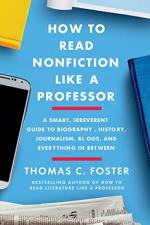
|
| Name: _________________________ | Period: ___________________ |
This test consists of 15 multiple choice questions and 5 short answer questions.
Multiple Choice Questions
1. In Chapter 12, "Life from the Inside," what advantage does Foster say contemporaneous accounts have?
(a) They allow the writer to consult sources from a variety of viewpoints.
(b) They offer a long view on historical events.
(c) They offer a narrower--and therefore easier to understand--view of history.
(d) They allow the reader to understand the world as it is in the present.
2. In Chapter 10, "From the Inside Out," says that political cartoons and punditry are examples of what type of nonfiction?
(a) Opinion.
(b) Op-ed.
(c) News features.
(d) Immersive journalism.
3. In "Interrogating the Text," what does Foster say most authors will do?
(a) Make up sources and say that people spoke "on background."
(b) Try to get away with unsupported assertions.
(c) Craft arguments with a sympathetic audience in mind.
(d) Make it clear what their sources are.
4. In Chapter 11, "Life from the Inside," what does Foster tell us begins Ben Franklin's autobiography?
(a) The dramatic moment when the Declaration is signed.
(b) A description of Franklin's childhood.
(c) Excerpts from a speech Franklin gave while serving as Ambassador to France.
(d) A letter to his son.
5. In Chapter 11, "Life from the Inside," Foster discusses the use of parallelism. He is discussing what technique?
(a) The exact repetition of words and phrases.
(b) The repetition of grammatical structures.
(c) The use of tone that mimics the subject under discussion.
(d) The use of multiple, similar examples.
6. In Chapter 10, "From the Inside Out," what document does Foster call the "ultimate political expression of [the] Enlightenment insistence on the individual" (146)?
(a) Essay Concerning Human Understanding.
(b) A Room of One's Own.
(c) Apologia Pro Vita Sua.
(d) The Declaration of Independence.
7. In Chapter 11, "Life from the Inside," Foster points out that Ta-Nehisi Coates's Between the World and Me begins similarly to which other work?
(a) Apologia Pro Vita Sua.
(b) Dreams from My Father.
(c) The Year of Magical Thinking.
(d) The Autobiography of Benjamin Franklin.
8. In Chapter 9, "Living the News," which authors does Foster point out as not engaged in New Journalism?
(a) Capote and Agee.
(b) Breslin and Talese.
(c) Mailer and Didion.
(d) Woodward and Bernstein.
9. In Chapter 13, "On the Stump," what does Foster say that Wolff mostly wrote about before writing Fire and Fury?
(a) Food.
(b) Travel.
(c) Celebrities.
(d) History.
10. In Chapter 10, "From the Inside Out," which claim does Foster make about thesis statements?
(a) An implied thesis is more sophisticated than a directly stated thesis.
(b) It does not need to limit the content of the essay.
(c) A thesis can be placed anywhere in an essay.
(d) No one can truly come up with a "unique" thesis.
11. In Chapter 12, "Life from the Inside," Foster says that an author of a history about long-ago events is not really so much a reporter as a what?
(a) Critic.
(b) Compiler.
(c) Artist.
(d) Poet.
12. According to Foster in Chapter 15, "Reading Internet Sources," what two errors in thinking prevent people from embracing gatekeeping?
(a) They believe that all barriers are bad and that all people are good.
(b) They believe that all writers are honest and that all editors are dishonest.
(c) They believe that all gatekeepers are elitist and that all voices should be represented.
(d) They believe that all nonfiction is accurate and that all critics are misguided cynics.
13. Based on Chapter 14, "The Universe of Ideas/Ideas of the Universe," what would Foster call a journalist writing about a biologist and her discoveries?
(a) Journalistic compilation.
(b) Amateur profiles.
(c) Expert testimony.
(d) Interrogation of text.
14. In Chapter 11, "Life from the Inside," what does Foster call the "most famous" African American autobiography (171)?
(a) The Autobiography of Malcolm X.
(b) Narrative of the Life of Frederick Douglass.
(c) Between the World and Me.
(d) Dreams from My Father.
15. In Chapter 10, "From the Inside Out," which writer does Foster credit with originating the essay?
(a) George Orwell.
(b) Virginia Woolf.
(c) Michel de Montaigne.
(d) Rene Descartes.
Short Answer Questions
1. In Chapter 14, "The Universe of Ideas/Ideas of the Universe," what criticism does Foster level against Malcolm Gladwell?
2. In Chapter 15, "Reading Internet Sources," what does Foster say the main role of editors is?
3. In Chapter 14, "The Universe of Ideas/Ideas of the Universe," what does Foster seem to admire most about Neil deGrasse Tyson's writing?
4. In Chapter 10, "From the Inside Out," why does Foster not capitalize the name of bell hooks?
5. In Chapter 11, "Life from the Inside," what does Foster call works that people write about their own experiences with illness and dying?
|
This section contains 828 words (approx. 3 pages at 300 words per page) |

|




